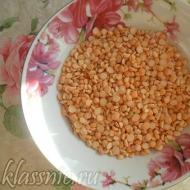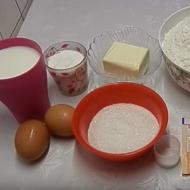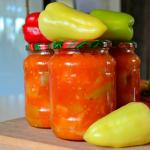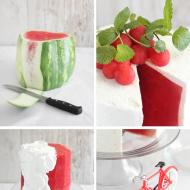
Useful properties of pomegranate wine, recipes. Yakhontovoe is ours! Making precious wine from pomegranates From pomegranate juice
Pomegranate is a very healthy and simply fabulously beautiful berry, decorated with a crown, each seed of which is surrounded by a bag of sweet and sour juice, reminiscent of a precious ruby. Due to the excellent taste of pomegranate, it has been used in cooking and winemaking in the East for several millennia. At home, pomegranate wine can be prepared according to two recipes - with and without yeast.
Yeast-free pomegranate wine recipe
To prepare, you need 5 kg of ripe pomegranates and 1.2 kg of sugar. The pomegranates are washed, the white membranes are removed, the grains are removed and poured into an enamel pan. Then the grains are crushed with a masher or by hand to release the juice, and sugar is added. After the sugar gets wet and partially dissolves, the contents of the pan are placed in a special large fermentation bottle, closed with a water seal or a rubber glove pierced in several places with a needle is put on its neck.
The bottle is placed in a warm place for 5 weeks and the fermentation process is monitored throughout this period. If it does not flow intensively enough, then to ensure additional tightness the neck of the bottle is coated with plasticine.
When the glove is deflated or air bubbles and foam no longer come out of the water seal, you can consider that fermentation is complete and the pomegranate wine is almost ready. Then the fermentation bottle is opened, the wine is filtered, bottled, corked and kept in the cellar for about a month, after which it becomes ready for drinking.
Recipe for making pomegranate wine using yeast
To obtain this drink you will need 6 pomegranates, a pack of wine and 1 tsp. regular yeast, 12 cups water, 1 Campden tablet, 4 cups sugar, 450 g raisins, 1 tsp pectin enzyme, 2 tsp mixture of malic, citric and tartaric acid.
Pomegranates are peeled and filmed, the grains are placed in a pan and thoroughly kneaded. All ingredients except yeast are added to the released pomegranate juice. Mix the wort thoroughly and leave overnight. In the morning, add yeast to the mixture and mix again. The pan is placed in a dark place for a week, during which the mixture is stirred daily.
The pomegranate wine must is filtered and poured into a bottle for fermentation. Install a water seal on it and place it in a warm place.
After 3 weeks, when fermentation is complete, the wine is bottled and stored in the cellar for at least 3 months, and experts recommend aging pomegranate wine for at least a year.
If you don’t really want to tinker with pomegranate fruits, you can make wine at home using juice. The ingredients also include water, in an amount of 50% of the total volume, and sugar. If you like the presence of acid in the taste, take sugar at the rate of 250 g per liter of juice, but if you want a sweeter drink, the sugar concentration can be increased to 400 g.
The technology itself is quite simple and looks like this:
- Bring the mixture to the required composition and pour into jars.
- After this, add a handful of raisins to each container, cover with a glove and leave in a warm place.
- After the fermentation process comes to an end, the drink is filtered to remove sediment and bottled.
- After 2–3 months of ripening the wine in a cool place, the taste becomes more intense.
Yeast recipe
Homemade pomegranate wine is often prepared with the addition of natural or factory yeast. The proportions of the ingredients are as follows:
- 5 kg of pomegranate fruits;
- 350 g of sugar per 1 liter of juice;
- 50 ml of water per 1 liter of juice;
- 1 package of wine yeast.
The algorithm of actions is as follows:
- From the washed and peeled pomegranate, grains are obtained, which should then be crushed to obtain juice.
- After this, add 150 g of granulated sugar per 1 liter of juice, yeast and water. Everything is thoroughly mixed and left in a cool room for 3-4 days. Be sure to stir the resulting wort daily.
- Then, the liquid is filtered and poured into a bottle, where it will ferment. At this stage, 100 g of sugar is added to the mixture, everything is mixed and a water seal is installed.
- The bottle is placed in a room with a temperature of 19–22 degrees for 21 days, and every 4 days 50 g of sugar is added and everything is thoroughly mixed.
- After fermentation is complete, the drink is filtered using a thin hose, bottled and aged for another 4 months in a cool room.
- If precipitate re-forms, the filtration procedure is repeated.
- Homemade pomegranate wine is ready.

Pomegranate wine has a pleasant and memorable taste, and the number of recipes for home preparation is very large. This wine is perfect for serving with fruit in the company of friends and family, or for a romantic evening.
Pomegranate is considered an incredibly healthy product, but many people do not like to eat it fresh because of its sour taste and abundance of grains. But in vain - in addition to the abundance of vitamins and minerals, it can increase appetite and refresh during the hot season. Pomegranate wine began to be made relatively recently due to the fact that the fermentation process was disrupted - insufficiently sweet pomegranates were selected, and as you know, sugar is necessary in the fermentation process.
Nowadays, you can buy pomegranate wine in any store, and if you want to make it yourself, it will turn out no worse. All you need to do is choose the appropriate recipe and strictly follow the instructions. This article will tell you about the rules for preparing, selecting and storing the drink.
The benefits and harms of pomegranate
As can be seen from the chemical composition, pomegranate contains many vitamins, minerals and trace elements necessary for the normal functioning of the body.
Pomegranate - (from Latin - Punica granatum) a fruit that is grown in South America, the Middle East and Western Asia. Belongs to representatives of the genus of pomegranates.
In Russia, this miracle fruit is cultivated in the Sochi region. On the territory of the former USSR in Azerbaijan, Armenia, Georgia, as well as in Crimea.
It is worth noting that the pomegranate tree (see photo) lives on average 100 years, and will not bloom if it receives little sunlight.
- Despite the fact that pomegranate has been known in Russia not so long ago, it has managed to gain great popularity.
- Mainly due to its unique sweet and sour taste and amazing amount of beneficial properties. The benefits and harms of pomegranate have long been studied - more on that below.
What is pomegranate made of?
- The fruits of the pomegranate tree have a dark red or less yellow tint and range from 9 to 18 cm in diameter.
- Inside there are many small seeds, surrounded by very juicy, sour-sour burgundy pulp.
- The number of seeds depends on the diameter of the fruit and usually ranges from 400 to 900 units, which in turn carry a lot of benefits for the human body.
Chemical composition of pomegranate

How pomegranate wines are made
There is no special secret in the production of this drink, because it is prepared using standard winemaking technology.
- The fruits are collected, peeled, and then placed in special containers to allow the drink to ferment.
- When the alcohol level in the wort reaches 6-7%, the process stops.
- Further, the technology is very similar to the traditional recipe for making dessert wine.
As a result, the strength of the drink reaches 16%. Some producers age pomegranate wine in special oak barrels.
Regions of production
- The technology was first mastered in Israel. Today, Israelis make it from fruits grown in the Upper Galilee. No sugar is used in production. The result is an exclusively natural product. Rimon is the most popular modern brand of Israeli pomegranate wine.
- Production has also developed in Armenia, and the product is popular not only in its homeland, but also in many countries around the world. In Armenia, fruits grow that are most suitable for making delicious dry and semi-sweet wine.
likerenc.ru
Secrets of production
As can be seen from the reviews, pomegranate wine leaves a complex impression on those who try it for the first time. They note that it has a rather unusual taste, not at all similar to grape. But the production process is quite close. The fruits are cleaned, filled into special containers and allowed to ferment naturally.

The preparation of pomegranate wines is very similar to how dessert grape alcoholic drinks are created. Some producers offer unique aged wines to those interested. Pomegranate wine stays in barrels for decades!
The value of such a drink is very high, but, as gourmets say, the taste and aroma are worth it.
syl.ru
The largest producer "Ararat"
This trust has been considered the center of Armenian winemaking art for several decades now. Curious tourists can visit the museum, which tells a lot of interesting things about the history and technical aspects of making wine.

The trust’s collection today includes about three thousand unique varieties of alcoholic beverages, some of the containers have been aged for more than a century. Currently, there are only three such large-scale storage facilities with “liquid gold” in the whole world - in addition to Armenia, Italy and France have wealth.
- Ararat positions itself as a company that values traditions and uses ancient methods of making wine.
- Only oak barrels are used here, classics reign in everything.
- Some winemakers still use karas - traditional containers for storing wine made of clay.
How to make pomegranate wine at home
Many people are curious: is it possible to make pomegranate wine at home? Indeed, there is nothing complicated about this, you just need to stock up on fruits, time and patience.
For homemade wine, five kilograms of pomegranate requires one and a half kilograms of sugar. Success will largely depend on constant monitoring, since the pomegranates on sale in our stores are low in sugar, so the quality of the drink is entirely determined by its addition during preparation.

- The fruits are thoroughly washed, the grains are separated, kneaded by hand or with a pestle, mixed with sugar, then a water seal is installed, and the container is placed in a warm room for two and a half months.
- Every week it is necessary to stir the future wine so that the foam is distributed evenly throughout the volume.
- If the fermentation process does not begin, you can initiate it with a handful of raisins.
- When ready, the wine is decanted, filtered, completely removing sediment, sealed in jars for a month and allowed to settle.
- After this, you can serve the drink to the table. However, the taste will be even better if you let the wine sit for six months.
Selection and preparation of pomegranates
With the onset of cold weather, pomegranates appear on the shelves of domestic stores. The only drawback is their high cost. However, this does not stop real lovers of the exotic taste and delicate aroma inherent in pomegranate wine. Therefore, today there are quite a large number of recipes that allow you to prepare this wonderful drink at home.
In our climate zones, almost no one grows pomegranates, so wine is most often made from purchased fruits. Moreover, the sweeter they are, the more aromatic and tastier the drink itself will be.
Ripe fruits that do not contain any blemishes are best suited for winemaking. For example, rotten or moldy areas. If the pomegranates you buy are not perfect, use a sharp knife to remove any parts that are unsuitable for winemaking. If this is not done, the final taste of the wine may be ruined.
alko-planeta.ru
A simple recipe for making wine
Composition and correct proportions:
- ripe pomegranates – 5 kg;
- sugar – 1500–1800 grams;
- water – 50 ml per 1 liter of freshly squeezed juice.
The amount of sugar required to make wine can vary and depends on the sugar content of the fruit. At the same time, pomegranate has one significant drawback that affects the winemaking process.
It consists of high acidity, which must be eliminated, otherwise fermentation will not begin at all. This problem can be solved quite simply: by diluting the pomegranate wort with water and adding granulated sugar to it.
Making wine from pomegranate is quite easy. The main thing is to adhere to a clear sequence of actions and not deviate from the steps below.

Preparing sourdough
Making wine begins with preparing the starter or purchasing wine yeast. Pomegranate seeds do not contain yeast cultures, so the fermentation process itself will not begin. To start and maintain the reaction, you can add purchased wine yeast or a pre-prepared starter to the wort.
Sourdough can be made from any unwashed fruit (cherries, raspberries, plums) or raisins, and its use will make it possible to activate the fermentation process. Moreover, it must be made 3-4 days before the start of making wine.
- Raisins or fruits are poured into a jar, a small amount of sugar and 100–200 ml of water are added to them.
- After which all the components are thoroughly mixed, and the container is covered with a piece of gauze.
- It should be placed in a dark, warm place and left to infuse.
- After 3-4 days, when the starter is completely ready, you can begin processing the main ingredients.
Pomegranate preparation
- The fruits are washed and peeled, since pomegranate wine is made only from seeds.
- Juice is squeezed out from the prepared grains. A special juicer is ideal for this, and if you don’t have one, then any other tool you have on hand will do. For example, a meat grinder or blender.
- Freshly squeezed juice is poured into a wide container, water, sugar (at the rate of 150 ml per liter of liquid) and starter are added. After which all components are thoroughly mixed.

The neck of the container is tied with several layers of gauze to prevent midges or other insects from getting into the wort. It is transferred to a dark, warm place and left there for several days. Once or twice a day, the mixture is stirred using a wooden stick or a clean hand.
Fermentation process
After 3-4 days, characteristic signs of fermentation should appear, such as bubbling, foam formation and a specific smell. If such signs occur, it means that the process of making wine is going according to plan.
- The future pomegranate wine is filtered through a sieve or several layers of gauze so that we get pure juice. In this case, the pulp is thoroughly squeezed out, and the liquid obtained from it is mixed with the juice.
- After 2-3 days, the remaining sugar is added to the fermented juice, after which the wort is thoroughly mixed and poured into a bottle, where the drink will play until it is completely ready. The container should be filled to no more than 75% of the total volume, otherwise carbon dioxide will not be able to fully escape, the bottle will burst and the wort will spill onto the floor.
- A shutter is installed on the neck, the second end of which is lowered into a jar of water or a medical glove is put on with a small hole pre-made in the finger.
- The bottle is moved to a dark, warm place where the drink will reach its condition.

When the fermentation process comes to an end, and this will happen no earlier than in 30–50 days, the young wine must be drained from the sediment. Determining its readiness is quite simple: the shutter will stop gurgling (the glove will fall), and the liquid will become much lighter.
The fermented wine is bottled using a small tube, which allows the light part to be separated from the sediment as accurately as possible. If desired, the finished drink can be made a little sweeter or stronger using vodka.
How to store pomegranate wine
- Hermetically sealed bottles are moved to a cool, dark place with a constant temperature of 5–15 degrees Celsius and aged for 4 to 6 months. A basement or cellar is ideal for these purposes. Long aging will make it possible to make the aroma of alcohol more integral and balanced.
- After this time, homemade pomegranate wine will be completely ready. It needs to be drained again, separated from the sediment. Then fill it with washed glass bottles. You can store it in the basement or in the refrigerator for 2-3 years.
By following this technology, you can get 1.5–2 liters of excellent wine, the strength of which will be 11–13 degrees. At the same time, its taste qualities will be much fuller and more multifaceted than that of any purchased analogue. Homemade pomegranate wine is perfect for desserts or fruit slices.
alko-planeta.ru

Recipe for pomegranate wine with yeast
- Grenades – 6 pcs;
- Water – 12 glasses;
- Sugar – 1 kg;
- Wine yeast – 1 pack;
- Pectin enzyme – 10 g;
- Regular yeast – 10 g;
- Campden tablet;
- Raisins – 2 cups;
- Citric acid – 2 tsp.
Preparation:
- Peel the pomegranate from the peel and membranes, mash the berries thoroughly, add all the ingredients to the juice, except yeast.
- Mix well and leave overnight, then add yeast to the mixture and place the container in a warm place.
- Let the wort sit there for a week, don’t forget to stir every day. Then filter the drink and pour it into a container in which it will ferment, install a hydraulic seal on the container.
- The container with wine should be in a warm place. The fermentation process will last approximately 3 weeks.
- Then pour the pomegranate wine into glass bottles and store it for 3 months. Some winemakers advise aging the drink for about a year.

Another recipe with yeast
- pomegranate – 5 kg;
- granulated sugar – 990 g;
- wine yeast - 1 package;
- filtered water – 150-250 ml.
To make wine, we will use pure pomegranate juice.
Wort preparation
- To do this, we break the pomegranate fruits into pieces and remove the grains, freeing them from white films, which, if they get into the juice, can give it unnecessary bitterness. Squeeze the juice from the grains in any convenient way and measure its amount.
- For each liter of product, at the initial stage we add one hundred and fifty grams of granulated sugar, fifty milliliters of purified water and wine yeast, which must be diluted according to the instructions on the package.
- Stir the mixture well, pour it into a bottle or jar, cover it with a piece of gauze and place it at room conditions for three to four days.
- If all recommendations are followed correctly, during this time the mixture should ferment, foam and acquire a sour smell. It's time to strain it through several layers of gauze.

To the resulting liquid base, add one hundred grams of granulated sugar for each liter, stir thoroughly so that all the crystals dissolve and pour the mixture into the fermentation vessel, filling it no more than three-quarters, leaving room for foam. We install a water seal on the container or simply put on a glove with a punctured finger and place it in a dark place with a constant room temperature.
During the fermentation process, on the fourth and eighth days from the beginning, add fifty grams of sugar for each liter of wort. To do this, drain about a liter of liquid, dissolve all the granulated sugar in it and pour the mixture back into the container.
What should the finished wine taste like and how to store it
Upon completion of the fermentation process, as evidenced by a deflated glove or the absence of air bubbles in a glass of water, drain the young homemade pomegranate wine from the sediment, taste it and, if there is enough sugar, bottle it.
The vessels should be filled to capacity and sealed hermetically to eliminate the access of air. We place the containers for four to six months in a cool, dark place, draining the sediment monthly and, if desired, additionally filtering it. The temperature in the room should be in the range from five to fifteen degrees plus.
- You can first give the drink strength by adding a little alcohol or vodka.
- Its amount can vary from two to ten percent of the total amount of pomegranate homemade wine.
The longer the wine is aged after this, the better its quality will be at the end. During the aging process, the taste of the drink will become more balanced and harmonious. Its complete readiness will be indicated by the cessation of sedimentation, as well as a transparent and rich color and a delicate wine aroma with subtle pomegranate notes.

If the first sample of the wine after fermentation shows that the drink is insufficiently sweet, then add sugar to taste, put it back on for additional fermentation, and only after its completion we bottle it and send it to age in a cool place.
womanadvice.ru
Recipe for pomegranate wine with raisins and yeast
Let's look at how to make a drink using yeast.
Ingredients
- 7 ripe pomegranates;
- 1.2 kg sugar;
- packaging of wine yeast;
- 100 g raisins;
- 2.5 liters of water.
Only ripe fruits are selected for wine; rotten and moldy grains should be thrown away. Otherwise the wine will spoil.

Preparation
- Wash, peel and remove all the grains from the pomegranate.
- Add sugar.
- Crush the grains with a spoon to release the juice.
- Strain through a sieve.
- Pour the wort into a tall container.
- Add yeast and raisins.
- Place in a warm, dark place for a week.
- Pour the wort into a bottle and put on a rubber glove with a hole on top.
- Monitor the wort during fermentation.
After a month, you can bottle the finished wine. Place in a dark place for four weeks to ripen. It is best to wait two years. In this case, the wine will acquire an unsurpassed rich taste.
The drink can be prepared without yeast. For fermentation to occur, the entire grain must be placed in the bottle, not just the juice. The cooking technology is similar to the previous one. For 5 kg of fruit you need to take 1.2 kg of sugar.
Pomegranate wine has a unique taste and nutty aftertaste. Its thick consistency makes the drink aristocratic. Wine prepared at home is very beneficial for the normal functioning of the entire body.
wday.ru

Pomegranate wine without yeast
To prepare you will need:
- Ripe pomegranates – 5 kg;
- Sugar – 1.2 kg;
Preparation:
- To begin, wash the pomegranates, remove the white membranes, remove the grains and place them in an enamel container.
- After this, you need to extract pomegranate juice from the grains; to do this, crush the berries with your hands or a masher. Add sugar to it.
- As soon as it gets a little wet and begins to dissolve, place the contents of the pan in a special large bottle, where the fermentation process will take place.
- Close the container with a water seal or put on a rubber glove and pierce the neck with a needle in several places.
- Place the bottle in a warm place for five weeks and monitor the fermentation process throughout this period.
If the wort does not ferment intensively enough, then you need to ensure additional tightness, namely, coat the neck of the bottle with plasticine. Once the glove is deflated or foam and air bubbles no longer come out of the water seal, we can say that the fermentation process is over.
After this, open the fermentation bottle, strain the wine and pour it into bottles, cap them and keep them in the cellar for a month. After this period, the wine is considered ready and can be consumed. As a result of preparation, you will receive a drink with a strength of 16%.
Homemade pomegranate wine is an excellent dessert drink. To prepare it, you can use either natural pomegranate juice or squeeze it yourself from ripe fruits.
The drink has an unusually light aroma and a pleasant nutty aftertaste, the wine is slightly tart but pleasant, all this makes up the taste of a very healthy pomegranate wine that will undoubtedly appeal to even the most sophisticated gourmets. Also, the drink has not only an unusual and memorable taste, but also a unique color. It is very rich, the palette is rich, not only in red, but also in golden colors, especially when the rays of the sun fall on the wine.
alkozona.ru
Pomegranate wine with barley
A classic American recipe described by respected Texas winemaker Jack Keller. For this recipe, you need pomegranates that are sweet and not very sour - these are the ones that are common in the USA.
- ripe pomegranates – 12-15 large
- barley groats – 225 g
- juice of one lemon
- sugar – 1.3 kg
- water – 4 liters
- yeast and fertilizing - according to instructions

- The cereal must first be boiled for 5-10 minutes, in half of all the water.
- Peel the pomegranates, pour the grains with hot barley broth through a sieve so that the spent grain does not get into the wine, add sugar and lemon juice, the remaining water, stir everything well.
- When the mixture has cooled to room temperature, add yeast and fertilizing.
- When signs of fermentation appear, pour the mixture into a bottle and place it under a water seal for 5-7 days.
- At the end of the primary fermentation, drain the wine and squeeze the pomegranate pulp well.
- We pour the drink into a smaller bottle almost to the top, put it under the seal again and transfer it to a cool place for another couple of months. During this time, the wine must be drained from the sediment several times.
- If it no longer forms, it means it’s ready, the wine can be bottled for aging. The organoleptic properties of the drink will improve over the course of a year if stored properly, so it is better not to drink it all at once.
By the way, homemade pomegranate wine is not only a tasty and aromatic drink, but also a folk remedy! This drink contains a lot of useful things - linoleic acid, which can normalize lipid metabolism, neutralize carcinogens, improve immunity, and antioxidants (more than in red grape wine), which slow down aging, and vitamins C, P, B6, B12, and antiviral tannin. .

Such a drug strengthens the walls of blood vessels, has a beneficial effect on the nervous system (of course!), and cleanses the body of toxins. But, of course, the benefits and harms of pomegranate wine directly depend on the amount consumed - if you lap it up in small cans, nothing good will come of it.
Homemade pomegranate wine with orange, raisins and lemon
Making such a wine is not difficult, the ingredients are, in general, quite accessible, and it should turn out delicious, since the rather monotonous taste of pomegranate will be shaded by citrus fruits, and raisins will give the drink “body” - additional density, strength and a deep nutty aroma.
- 20 large ripe pomegranates
- 1 kg raisins (or 0.5 kg raisins and 0.5 kg dried blackcurrants)
- 4 oranges
- zest of 4 lemons
- sugar – 2.5 kg
- water – 7.5 l
- wine yeast and fertilizing for 15 liters of wort

The recipe is almost the same as the previous two.
- Peel the pomegranates, mash them, add water, add raisins, sugar, thinly cut the zest from the oranges and lemons, add to the wort, and also squeeze the juice out of the oranges.
- Add yeast along with fertilizing. When fermentation begins, pour the wort into a suitable vessel, install a water seal and transfer to a warm place.
- When fermentation is over, drain the liquid and squeeze the pulp thoroughly.
- Pour everything into a smaller bottle, set aside in a cool place for a couple of months, and decant periodically. After clarification, pour into bottles.
- It will be possible to uncork the first one in six months.
It seems clear how to make homemade wine from pomegranate. How and with what do you drink pomegranate wine? This is a rather viscous and dense drink, more tart and rich than red grape wine. Tasters distinguish bright nutty notes, shades of cherry and tobacco in the aftertaste.
Dry varieties are great as an aperitif, sweet varieties are great for desserts, especially fruit ones, as well as for a cigar or pipe.
This drink is served slightly chilled - up to 14-15 degrees. And don’t forget to enjoy the color of the wine in the glass before tasting - if everything is done correctly, it will be amazingly beautiful, the color of a pomegranate peel with a noble golden tint.
therumdiary.ru

Classic pomegranate wine recipe
- We bring the ingredients from the store to the desired composition. If the purchased drink is too diluted, evaporate it. Often found with a natural product content of at least 30% - reduce it by almost half, do not add water. The sugar content will double, which may be enough.
- Pour juice with sugar into clean jars, add a handful of dark raisins, cover with a medical glove or water seal and place in a warm place until fermentation is complete.
- Drain the clear drink from the sediment. We bottle it. We carefully seal them and put them in a cool place to ripen. After a couple of months, the wine will become much tastier.
Pomegranate wine retains all its healing qualities and has a unique, pleasant taste. The drink will not only add health to you, but will also surprise your friends if you serve it with fruit for dessert.
samogonpil.ru
The benefits and taste of pomegranate wine
Researchers have found that all the vitamins from pomegranate fruits are preserved in wine for several years due to the alcohol content.

- Its taste improves your mood and gives you a boost of energy.
- The antioxidant level of pomegranate wine is three times higher than that of ordinary red wines and even green tea.
- This means that the aging process of the body slows down significantly.
- And linoleic acid from pomegranate seeds suppresses the development of cancer cells.
The benefits of pomegranate wine are undeniable if consumed in small quantities.
The wine has an amazingly rich color with a ruby tint. The flavor bouquet is pleasant, balanced with slight tartness, fruit and almond notes, with a long nutty aftertaste. Before drinking, pomegranate wine should be cooled to 12 or 14 degrees.
These drinks are very easy to drink and can be enjoyed without even having a snack. This applies to dry wines. If you drink pomegranate dessert wine, it is recommended to eat it with sweet desserts or fruits. Once you prepare such a wonderful alcoholic drink, it will be impossible to refuse it.
alkorules.ru
How to drink pomegranate wine correctly
Pomegranate wine is consumed only chilled, the temperature should not exceed 14°C.

- Such wines are pleasant to the taste, they are sweet, along with this a slight tartness is perceptible, but there is definitely no cloying in such a product.
- The most important distinguishing characteristic of the wine is a nutty aftertaste with slight notes of tobacco and cherry.
- Pomegranate wine is very pleasant and easy to drink, so most people drink this wine without a snack.
However, wine experts confidently place it on a par with dessert alcoholic drinks, and therefore it is recommended to combine pomegranate wines with fruits or sweet desserts. Pomegranate wine has a beautiful color, reminiscent of the shade of the peel of the fruit itself. This wine differs from other wines in its increased density and density.
- Drinking pomegranate wines is very beneficial for the human body, since, according to scientists, it has high antioxidant activity, which slows down the aging process.
- Linolenic acid present in pomegranate significantly suppresses the effects of carcinogenic substances that can cause cancer. Therefore, pomegranate wine is very healthy, but only if consumed in moderation.
There are more and more connoisseurs and gourmets of pomegranate wine every year. Of course, it does not constitute competition for grape wine, but the number of points where you can purchase such wine has increased, including in Russia.
alcorecept.com

What is pomegranate wine served with?
Pomegranate wine is served chilled to 12-14⁰C.
- This is a dessert wine that goes well with fruit, dessert, and soft cheese.
- The drink has a dense, thick consistency, tart taste and dark red color with shades of ripe fruit peel.
- The wine can be drunk without a snack; an original aftertaste with notes of nuts, cherry, and tobacco remains in the mouth.
fountravel.ru
The most famous distillery in Armenia
Armenian pomegranate wine, like a number of other alcoholic drinks, is produced mainly on the basis of the Ararat trust. Ancient winemaking traditions, compliance with all international requirements and a proven recipe make the products of this Armenian manufacturer one of the most famous not only in the CIS, but also in the West.
Azerbaijan, however, also does not lag behind its competitor. The territory of this state is suitable for growing the necessary selection of pomegranate, which allowed wines from Azerbaijan to enter the global market.
The best Armenian wine made from pomegranates, according to a number of sommeliers, is Arame (red, semi-sweet).
- Unlike dry analogues from Israel or Azerbaijan, Arame is more suitable for the mass consumer, as it has better taste.
- “Aram” has a thick, rich taste, perfect for pure savoring or as a substitute drink for meat dishes.
- The color of “Arame” is deep red, less often brownish, the taste is tart and pronounced.
- Armenian wine is valued for its high quality, honed over years of following the recipe and polishing acquired skills, and “Arame” is no exception.
vse-vino.ru

Technological process
Winemaking using pomegranate is not fundamentally different from the traditional version. Pomegranate juice is more acidic due to the presence of vitamin C and iron. During the alcohol production process, this acidity is reduced, after which the usual fermentation begins. If we look in more detail, the process of preparing pomegranate wine can be divided into several stages:
- preparation: fruits are collected, washed and peeled;
- preparation: fruits are placed in fermentation tanks, additional ingredients are added;
- fermentation: the resulting solution is left for some time, this process stops when the alcohol concentration in the wort is 7%.
Winemakers from Armenia, as well as from Israel, use both a special variety of pomegranate and a regular one. The result is two lines of alcohol: dry and semi-sweet. Most vintage drinks from Armenia or Azerbaijan are aged for 10 years in French oak barrels, which is a conventional standard for dessert analogues. The final strength of the drink does not exceed 16 degrees.
About fakes
Before you buy pomegranate wine in a store, you should pay attention to several factors that will help you easily determine whether the drink is a surrogate or a low-quality mixture.
Here are some of them:
- the label is missing or damaged;
- the drink has an extremely liquid consistency;
- the country of origin is not indicated or there are no signs of a specific enterprise;
- some composition data is missing;
- pronounced smell of ethyl;
- sickly sweet taste, chemical aftertaste.
Pomegranate wines do not yet constitute significant competition to grape analogues due to the limited varietal base for production. However, this makes it possible to immediately determine whether the purchased drink is counterfeit.
If the alcohol was not made in Armenia, Azerbaijan or Israel, then it is likely that there is a fake on display, which only has a pomegranate flavor due to additional impurities.
vse-vino.ru
Benefits and beneficial properties of pomegranate
As can be seen from the chemical composition, pomegranate contains many vitamins, minerals and trace elements necessary for the normal functioning of the body. You need to know the four main vitamins of pomegranate. These are C, P, B6 and B12.
What is their key role?
- Vitamin C, which is found most abundantly in pomegranates, has strengthening effects on the immune system.
- Vitamin P will strengthen your blood vessels.
- B6 - strengthens the nervous system
- B12 – improves hematopoiesis.

But that's not all!
- In addition, pomegranate also contains many acids, fiber and tannin.
- Pomegranate tannins work well against tuberculosis, dysentery and E. coli, and is also a disinfectant. Separately, it is worth noting the tannin substance, which has an astringent property and helps cope with diarrhea.
- Pomegranate perfectly strengthens the walls of blood vessels, the nervous system and blood circulation in general. Doctors recommend that elderly people and those who have undergone surgery pay attention to this. Since their body needs a strengthening effect most of all.
- In the treatment and prevention of colds, thyroid disease, heart disease, pomegranate again comes to the rescue.
- It is also recommended to pay attention to the fruit for patients with atherosclerosis, malaria, anemia and exhaustion of the body. The vitamins and microelements of pomegranate will help you cope with these diseases faster.
If you regularly take ripe pomegranate fruits, it will help naturally lower blood pressure in patients with hypertension. Natural amino acids that enter our body through pomegranate fight pathological cells at the cellular level, helping to establish negative processes.
Regular addition of this oriental fruit to your diet prevents the development of stomach cancer.
Pomegranate is also useful for those who have bronchial asthma and anemia. The pulp and juice help remove radioactivity from the body.
The beneficial qualities of pomegranate are difficult to overestimate. It has an almost positive effect on all diseases. And considering that it is also delicious! You can cook a lot of delicious, and most importantly healthy dishes with it.
True, its richness of vitamins (in such large quantities) is preserved only in fresh form. Therefore, when preparing it, it is worth taking this into account.
Benefits of pomegranate seeds
Many people don't like pomegranate because it contains a lot of grains. Not at all. After all, how many benefits are there! Ground pomegranate seeds help relieve headaches and reduce high blood pressure. They also promote hormonal activity in the body.

Even juice and essential oils are made from pomegranate seeds. Oil – used in cosmetology. The juice has a diuretic effect and is therefore beneficial for the kidneys and liver.
Useful properties of pomegranate peel
- A powder is obtained from the pomegranate peel, which has a highly astringent effect and can cure enterocolitis.
- The powder can also be used as a powder for scratches and cracks in the skin.
- A decoction of the peel helps to cope with colds. (BUT! See harmful properties)
- In addition, it helps remove worms from the body. Pomegranate bark contains alkaloids that have an anthelmintic effect.
- When rinsed, the solution from the peel can cure stomatitis and bleeding gums.
Do not forget the beneficial properties of pomegranate partitions. The dried partitions are dried and added to tea. This tea normalizes the nervous system and has a calming effect, as well as cope with insomnia.
Harm and contraindications of pomegranate
In addition to its beneficial effects on the human body, pomegranate has a number of contraindications.
- Pomegranate juice is contraindicated for people with chronic stomach diseases, such as gastritis with high acidity and peptic ulcers.
- It is not recommended to use this juice for children under 1 year of age. Until 4-7 years, it would be useful to dilute the concentrated juice with water.
- Store-bought pomegranate juice, although it is easily available, should not be consumed; it can be very harmful to humans due to all sorts of unnatural additives from the manufacturer.
- When taking the juice orally, it is very important to follow the recommendations of dentists. Freshly squeezed pomegranate juice has a detrimental effect on tooth enamel due to the various acids it contains. To prevent this, you should dilute it with water, keeping in mind that the entire storehouse of vitamins will be preserved. And after taking, rinse your mouth with water.

- It is not recommended to use the juice for people suffering from hemorrhoids and chronic constipation.
- For gastritis, enteritis and peptic ulcers, pomegranate seeds are contraindicated.
- The use of pomegranate peel should be with special attention, since in addition to its beneficial properties the peel contains harmful substances– isopelletierine, pelletierine, alkanoids. Therefore, when taking pharmaceutical preparations based on pomegranate peel or any homemade powders (tinctures, solutions), you should first consult a doctor!
chtoem.ru
Story
The sparkling ruby color, light nutty aftertaste, tart and delicate taste of wine determined the love for it in ancient times. However, the production of industrial pomegranate wine began only at the end of the 20th century. Israel became the pioneer in production. Türkiye, Armenia, and Azerbaijan picked up the baton after him. Nowadays, many countries produce a drink made from pomegranates. Particularly popular is the pomegranate sparkling wine “Rimon”, which is made in Israel. The unique technology, as well as the smell of strawberries, cherries and blueberries, distinguish it from other wines.
Compound. Pomegranate contains a large amount of acid and a small amount of sugar. Therefore, when making homemade wine, water and sugar must be added to the juice. These additives ensure normal fermentation. Tannins and tannins help wine to be stored for up to 3 years and to be resistant to disease.

Effect on the body. Pomegranate wine suppresses the activity of carcinogens and is a powerful antioxidant. It refreshes, improves appetite and mood, and also strengthens the body as a whole.
Drinking rules. Dry pomegranate wine is usually drunk an hour before meals (as an aperitif). Sweets - during or instead of dessert. The ideal temperature is 8-15°C. Cooks use this wine as a base for delicious sauces.
Snacks. Fruits, desserts.
Manufacturing secrets:
- Homemade or market-bought pomegranates are suitable for wine. They should not show signs of deterioration or mold. In addition, natural or store-bought juice is suitable.
- Due to the varying acidity and sweetness of pomegranates, it is ideal to use a pH meter and saccharometer when adding sugar and water. This will help you avoid making mistakes with the exact volumes of water and sugar that need to be added to the wine. The acidity level of the drink should be 0.7%, sugar content – 18-20%. In addition, you need to taste the wort: if it is sour, add water, add sugar.
- The yeast in any recipe must be special - wine yeast, otherwise the result may not be wine, but mash.
- Containers and utensils that will be used in cooking must be sterilized or scalded with boiling water and dried.
Homemade pomegranate wine
Yield (without adjusting the composition) – 1.5-2 liters, strength 10-12%, stored refrigerated – 2.5-3 years. The total weight of sugar in the recipe can be increased to 1.2 kg, the volume of water - up to 1-2 liters. 
Prepare:
- pomegranates (unpeeled) – 5 kilos
- granulated sugar – 350 gr. for 1 liter of juice (approximately 880 g)
- water – 50 ml per 1 liter of juice (approximately 125-130 g.)
- wine yeast - according to instructions
We will prepare the wine like this:
- We wash the fruits, clean them, crush the grains with a wooden masher. The result is approximately 2-2.5 liters of juice with pulp (about 1.5-2 liters of pure juice).
- We dilute the pomegranate mass with water, add some sugar (150 g per 1 liter of juice) and yeast (according to the instructions).
- We tie the container with the wort with gauze and leave it for 3-4 days. During this time, the wort will begin to hiss and foam.
- On the 4-5th day, strain the wort, squeeze out the cake and add another part of sugar to the resulting liquid (100 grams per 1 liter of juice). Close the container with juice with a lid and install a water seal.
- After 4 days, open the fermentation container, pour about a liter of wort, in which we dissolve another part of the sugar (50 grams per 1 liter of juice). After this, pour the sweetened wort back into the fermentation container and leave for another 4 days.
- On the 5th day, add the rest of the sugar to the wort (50 grams per 1 liter of juice). We do this as in the previous stage, mixing sugar with a liter of poured wort.
- The fermentation course is usually completed after 35-50 days. If fermentation is not complete, the wine must be separated from the sediment and left to ferment.
- We separate the young wine from the layer of sediment at the bottom, and, if desired, sweeten or fortify with vodka. The volume of strong alcohol added to wine should not exceed 40-200 ml.
- We pour the wine into a bottle (jar) right up to the neck, seal it and keep it in the basement (cellar) for 4-6 months.
- We separate the finished pomegranate wine from the sediment collected at the bottom and seal it in glass bottles.
American style pomegranate wine
Prepare:
- pomegranates (unpeeled, large) – 10 pcs.
- oranges – 2 pcs.
- raisins – 0.5 kilos (or 250 grams each of raisins and dried black currants)
- granulated sugar – 1.3 kilos
- water – 3.7 liters
- zest - from 2 lemons and 2 oranges
- wine yeast - according to instructions

We will prepare the wine like this:
- We wash the fruits, clean them, crush the grains with a wooden masher.
- We dilute the pomegranate mass with water, add orange juice, sugar, raisins, and zest. Add yeast.
- We tie the container with the wort with a cloth and leave it for 2-4 days. During this time, the wort will begin to hiss and foam. Close the lid and install the water seal.
- At the end of fermentation, strain the wort, squeeze out the cake, pour it into a bottle and let it sit for 2-3 months.
- After a couple of months, we separate the wine from the sediment that has collected at the bottom and seal it in glass bottles. We stand for 5-6 months.
Pomegranate juice wine
Prepare:
- pomegranate juice (fresh or store-bought 100%) – 2 liters
- granulated sugar – 0.5-0.8 kilos (250-400 g per 1 liter of juice)
- water – 1 liter (50% of the juice volume)
- dark unwashed raisins - 1 handful or wine yeast - according to instructions

We will prepare the wine like this:
- Mix the juice with water. If the juice bought in a store is 50%, then we take it in the amount of 3 liters and do not add water.
- Dissolve granulated sugar in the juice and add raisins (or introduce yeast). We close the container with a lid with a water seal and wait for the wort to ferment. This is approximately 35-50 days.
- We separate the wine from the sediment formed at the bottom and seal it in glass bottles. We stand for at least 3-6 months.
Pomegranate wine from Narsharb sauce
Prepare:
- grape juice (fresh or store-bought 100%) – 4.5 liters
- dextrose – 0.5 kilo + to taste
- Narsharb sauce – 1 bottle
- wine yeast - according to instructions
We will prepare the wine like this:
- Mix the juice with dextrose and add the yeast. We close the container with a lid with a water seal and wait for the wort to ferment.
- Separate the wine from the sediment collected at the bottom and dissolve the sauce in it. If necessary, sweeten with dextrose.
We stand for another 2-3 weeks, again separate from the sediment and seal in glass bottles.
https://alkolife.ru/vina/granatovie-sostav-recepti.html
Benefits of pomegranate wine
Pomegranate is a storehouse of micro- and macroelements, vitamins and other valuable substances. They contain a large amount of linolenic acid, which improves immunity and normalizes lipid metabolism. Vitamins C, P, B12, tannin, punicalagin and other substances contained in the fruits are preserved after fermentation. Thanks to this, the benefits of pomegranate wine are obvious:
- Has a powerful antioxidant effect.
- Strengthens the walls of blood vessels.
- Stabilizes the state of the nervous system.
- Removes waste and toxins from the gastrointestinal tract.
- Has a positive effect on connective tissue.
- Prevents the proliferation of pathogenic microflora in the oral cavity.
Of course, the positive effect is only relevant with moderate consumption of this alcohol. For an adult, the daily dose should not exceed 200-250 grams.
Cooking features
In order to make pomegranate wine at home, you need to follow certain rules:
- You should choose only ripe fruits with dry, hard, rough skin. It is better to leave spectacular smooth fruits with the remains of leaves on the shelf, as they are unripe.
- Pomegranate does not have enough tannins, so for complete fermentation it is necessary to use factory wine yeast or raisin starter.
- It is important to carefully clean the white chaff from the grains, as it will give the drink an unpleasant bitterness.
- Due to the low sugar content and large amount of acid, it is necessary to add water and a sufficient amount of sugar to the wort.
- Unripe, moldy and any other spoiled grains must be removed. Even a small amount of unusable grains will spoil the taste of the entire drink.

Of course, to prepare wine you should use only pre-sterilized containers and tools. Preference should be given to glass, wood, enamel, plastic utensils and utensils.
Cooking technique according to the basic recipe
The technique for preparing pomegranate wine is practically no different from grape wine, thanks to which even an inexperienced winemaker can make the drink. For this you will need:
- 5 kg pomegranate;
- 350g of sugar per liter of resulting juice;
- 50 ml of water per liter of juice;
- 1 package of wine yeast or 500 g of unwashed raisins.
First of all, purchased pomegranates need to be cleared of peel and white film. It is better to do this over a container, which will allow you to preserve a decent amount of valuable juice. The cleaned grains are kneaded with a wooden pestle in a container with a wide neck. The sequence of further actions is as follows:
- Yeast or pre-prepared raisin starter, sugar (calculated at 150 g per liter of juice), and water are added to the resulting berry mass.
- The mass is thoroughly mixed, covered with gauze and left in a room at room temperature for four days. To prevent souring, the wort should be stirred daily with a clean hand or a wooden spoon.
- On the fifth day, the pulp that has risen to the surface is removed and squeezed out through cheesecloth, and the wort itself is filtered.
- The wort is poured into a fermentation container, 100 g of sugar is poured into it, and a water seal is placed on the neck. Throughout the entire fermentation period, the suleya should be kept in a warm, dark room with a stable temperature of 18-22 degrees.
- Every four days the wort needs to be stirred and 50 g of the remaining sugar added to it.
- After fermentation is complete, which can be determined by the absence of bubbles in the water seal and the appearance of sediment at the bottom, the wine is drained using a thin tube.
- The young wine is bottled, corked and moved to the cellar for 4 months to mature. If sediment appears again during ripening, the drink should be poured into clean bottles.
Using the same recipe, you can make wine from pomegranate juice, but you should do this only if you are completely confident in its naturalness and impeccable quality. The result should be a dessert wine with a strength of no more than 13 revolutions. It is recommended to serve it chilled to 12-14 degrees. The drink goes well with fruits, desserts, and cheeses.
https://samogonhik.ru/vino/granatovoe.html
Alcoholic drink made from pomegranate
Pomegranate can be used to make dessert, fortified or dry wine, not to mention traditional semi-sweet wine. It is important to carefully remove the film from the grains.
If the fermentation process does not occur, you can cheat a little by adding a handful of raisins to the wine.
Pomegranate wine has one peculiarity - after filtering, it must be infused in glass jars or bottles for at least 2 months. It is better to leave the drink in a cool place for six months - then you will be able to appreciate the taste of the magnificent drink.
In general, finished wine can be stored for up to 3 years - in the basement or refrigerator.
For fermentation, a water seal should be installed on the container into which the wine is poured. You can replace it with a rubber glove, which is also a kind of indicator - as soon as it goes down, the wine can be filtered.

Ingredients:
- 2.5 kg of pomegranate – the weight of the grains is taken into account;
- 1 kg sugar.
Preparation:
- Wash the pomegranate fruits, peel them and remove the seeds - crush them well. Add sugar.
- Mix the mixture thoroughly and place it in the container in which you plan to infuse the wine. Put on a glove. Place in a warm room for 2 months.
- Stir the wine as often as possible. It is better to do this every day or 4 times a week.
- When the glove comes off, strain the liquid through a sieve or cheesecloth. Bottle the wine and let it brew for 2 months.
It is a common practice to infuse pomegranate wine in oak barrels. It is believed that it acquires an incomparable aroma and a subtle oak flavor. You can try this technology if you have a suitable container.
No, well, “precious”, of course, in a figurative sense, if you do not take into account the price of pomegranates in areas where they are not grown. However, this unfortunate fact has never stopped home alcohol enthusiasts, especially since from this common raw material you can produce a real treasure, not only amazingly beautiful, but also amazingly tasty! So let's arm ourselves, like medieval alchemists, with flasks and retorts, and try to create a jewel with our own hands - the noblest wine from pomegranate!
Pomegranate is an amazing fruit! There is not enough sugar in it (although some varieties can contain up to 20% sugars), but there are a lot of acids (up to 9% in some varieties), a rich and rich taste - the juice will need to be diluted with water for normal fermentation, which means we will get more product. Pomegranates also contain quite a lot of tannins and tannins, which will ensure good storage of the drink and its resistance to disease. There are many recipes for homemade pomegranate wines, today we will present you the most interesting and reliable of them - the simplest wine consisting only of pomegranates, water and sugar, and two classic American recipes: one with raisins, lemons and oranges, and the second with such an unusual additive, like... barley groats.
According to all three recipes, wine is made for quite a long time - about a year. If you want to get a tasty drink faster, use one of them; the same article describes life hacks for separating pomegranate seeds from... hmm, chaff, they will also help us in making wine. Many “experts” on the Internet advise adding acid mixtures and tannin to homemade pomegranate wine. In my opinion, this should not be done - the fruits themselves already have plenty of these substances. Also, do not believe recipes that indicate too little water - for example, 50 grams per liter of juice, this is not enough, we do not have such sweet and low-acidic varieties of pomegranates.
Pomegranate wine at home - first, basic recipe
Simple and lethal, like RGD-5. You don’t need anything for it except, in fact, pomegranate fruits, sugar and water. According to the classics, such wine ferments with wild yeast, but I would advise you to stock up on store-bought wine just in case. It’s winter after all, those “savages” who lived on the fruit could have died long ago from frostbite, and besides, we don’t use the peel. Of course, you can try to make raisin starter (), but it’s better not to skimp on ChKD - the wine on them will ferment faster and better, it will be stronger and more stable.
In fact, the proportions are very arbitrary. All pomegranates are different, their sweetness and acidity greatly depend on the time of collection, storage conditions, temperature and a whole bunch of other factors. Therefore, it is best to rely not on the recipe, but on your own taste sensations. You should definitely taste the wort, adjusting the taste with water and sugar. Too sour? We dilute it. Not enough sweetness? Add sugar. The most reliable way to navigate is with special winemaking instruments - a pH meter and a sugar meter; the optimal acidity is 0.7%, sugar content - 18-20%.

How to make homemade pomegranate wine? And just like any other berry or fruit wine!
- We clean the pomegranates by removing the grains. Place them in a suitable container and crush them thoroughly with a masher. Add a little - a couple of liters - of water, half the sugar, yeast and nutrient mixture (or raisin starter).
- We wait for it to ferment and place it in a warm place under a water seal - right along with the seeds. After a couple of days of active fermentation, when the pulp has softened sufficiently, the wort must be drained and the pulp thoroughly squeezed out.
- We taste the future wine and adjust the acid-sugar in the manner indicated above. These proportions are, in principle, universal and are suitable for pomegranate varieties common in the middle zone - that is, those that can be bought on the market, but it is better to focus on your own taste. When you are satisfied with the acidity and sugar content of the liquid, pour everything into a fermentation bottle.
- Active fermentation will continue for another 3-5 days (with wine yeast) or up to 40 days (with sourdough or wild yeast). The end of fermentation can be diagnosed by the clarification of the wort, the formation of a dense sediment of yeast and remnants of pomegranate pulp at the bottom of the bottle, and also by the fact that the water seal has stopped gurgling.
- We decant the young wine through a straw, pour it into a smaller fermenter at 90-95% of the volume and move it to a cool place – 10-12° – for further fermentation. Secondary fermentation usually lasts 2-3 months, during which time the wort needs to be decanted 3-4 more times if sediment forms.
- Once the wine has become completely clear and sediment no longer appears, you can bottle it. It is recommended to try no earlier than six months later.
Using the same method, you can make wine from store-bought pomegranate juice - the recipe is universal. But here everything greatly depends on what the manufacturer has stuffed into its products, how much water and sugar it contains, and how much juice itself. If you are lucky enough to purchase pure juice, you can follow the indicated proportions, otherwise they need to be adjusted. In this case, we will definitely need CHKD - you can’t get by with raisin starter; store-bought juice, treated with chemicals and pasteurized, is unlikely to ferment with wild yeast.
Pomegranate wine with barley
A classic American recipe described by respected Texas winemaker Jack Keller. To be honest, for the life of me I don’t understand why there is barley here. But, apparently, it does provide something - color, aroma, some substances needed by the wort, density... In general, you can experiment with the American classic, or you can simply do without this ingredient and make ordinary pomegranate wine. For this recipe, you need pomegranates that are sweet and not very sour - these are the ones that are common in the USA.
The cereal must first be boiled for 5-10 minutes, in half of all the water. Peel the pomegranates, pour the grains with hot barley broth through a sieve so that the spent grain does not get into the wine, add sugar and lemon juice, the remaining water, stir everything well. When the mixture has cooled to room temperature, add yeast and fertilizing. When signs of fermentation appear, pour the mixture into a bottle and place it under a water seal for 5-7 days. At the end of the primary fermentation, drain the wine and squeeze the pomegranate pulp well. We pour the drink into a smaller bottle almost to the top, put it under the seal again and transfer it to a cool place for another couple of months. During this time, the wine must be drained from the sediment several times. If it no longer forms, it means it’s ready, the wine can be bottled for aging. The organoleptic properties of the drink will improve over the course of a year if stored properly, so it is better not to drink it all at once.
By the way, homemade pomegranate wine is not only a tasty and aromatic drink, but also a folk remedy! This drink contains a lot of useful things - linoleic acid, which can normalize lipid metabolism, neutralize carcinogens, improve immunity, and antioxidants (more than in red grape wine), which slow down aging, and vitamins C, P, B6, B12, and antiviral tannin. . Such a drug strengthens the walls of blood vessels, has a beneficial effect on the nervous system (of course!), and cleanses the body of toxins. But, of course, the benefits and harms of pomegranate wine directly depend on the amount consumed - if you lap it up in small cans, nothing good will come of it.
Homemade pomegranate wine with orange, raisins and lemon
Also an American recipe, the authorship belongs to Dana Griet, a famous blogger and winemaker. Making such a wine is not difficult, the ingredients are, in general, quite accessible, and it should turn out delicious, since the rather monotonous taste of pomegranate will be shaded by citrus fruits, and raisins will give the drink “body” - additional density, strength and a deep nutty aroma.
The recipe is almost the same as the previous two. Peel the pomegranates, mash them, add water, add raisins, sugar, thinly cut the zest from the oranges and lemons, add to the wort, and also squeeze the juice out of the oranges. Add yeast along with fertilizing. When fermentation begins, pour the wort into a suitable vessel, install a water seal and transfer to a warm place. When fermentation is over, drain the liquid and squeeze the pulp thoroughly. Pour everything into a smaller bottle, set aside in a cool place for a couple of months, and decant periodically. After clarification, pour into bottles. It will be possible to uncork the first one in six months.

Appeared on store shelves relatively recently. Its production technology is more complex than grape wine. Due to its taste and beneficial properties, pomegranate drink is gradually becoming more popular, and it can be made at home.
Why and who benefits from pomegranate wine?
Pomegranate, which in the East is called the king of all fruits, is rich in vitamins and minerals. Consuming it increases immunity and the body's resistance to dangerous diseases.
Pomegranate wine retains the beneficial properties of the fruit grains. The linolenic acid it contains has a powerful antioxidant effect and can suppress the growth of cancer cells. Regular consumption of this drink helps reduce cholesterol and is a prevention of heart attacks, strokes and cerebral atherosclerosis. This wine strengthens the walls of blood vessels, cleanses the body of harmful substances, and also has a slight calming effect. All the beneficial properties of this drink appear only with moderate consumption.
Homemade pomegranate wine does not contain dyes, flavors or other chemicals.
A glass of this drink a day is recommended for people with weakened immune systems, vitamin deficiency, and after nervous and physical exhaustion.
Features of Armenian pomegranate wine
Pomegranate is a symbol of Armenia. In this country, special varieties of pomegranate are grown, from which dry and semi-sweet wine is prepared; the pomegranate for it must be ripe, juicy and aromatic. Armenian pomegranate wine is a special pride of local winemakers.
The drink is dark red in color, sweet and tart, with a soft cherry aftertaste with hints of nuts.
Small private producers still use special mechanical juicers and large clay barrels when making this drink. They honor traditions and use ancient recipes inherited from their ancestors.
The largest Armenian producer of alcoholic beverages is the Ararat plant. He has been making wine for many decades. “Ararat” keeps traditions, and oak barrels are used in its production. The size of its storage facility is second only to production facilities located in France and Italy. Wines are made here not only for the local market, but also for export. Pomegranate wine from Armenia can be found in Russian and European stores.
How to make pomegranate wine at home
Pomegranates contain a lot of acid, which can interfere with the fermentation process. To neutralize its effect, a large amount of sugar is added to the prepared drink. Pomegranate wine is made at home from fresh fruits and ready-made juice, with or without yeast. In this case, special wine yeast is needed; bakery yeast will not work. There are several most popular recipes, following which you can prepare a tasty, natural and healthy drink.
When using the classic recipe you will need:
- pomegranate fruits - 5 kg;
- sugar - 350 g for each liter of juice obtained;
- water - 50 ml for each liter of juice;
- yeast - the proportions should be looked at on the package, depending on the amount of liquid.
During manufacturing, the following procedure must be followed:
- Prepare grenades. Wash and sort the fruits, remove all rotten and moldy areas. Peel off the peel and white films, leaving only the grains.
- Prepare juice from the grains. You can mash them with your hands, a potato masher, or crush them in a mortar.
- Pour the juice and pulp into a wide-necked container. Add 150 g of sugar for each liter of juice and yeast, diluted according to instructions. Mix.
- Cover the neck with clean gauze and put the workpiece in a dark place at room temperature. Stir the liquid every day.
- The fermentation process will begin in 3-4 days. Foam will appear on the surface of the workpiece and a sour smell will be felt. At this point, the future wine needs to be strained through 3-4 layers of gauze. Squeeze out the remaining pulp well and add all the liquid to the juice.
- Add the next portion of sugar (100 g per liter) and mix well. Now the liquid needs to be poured into containers for subsequent fermentation, filling them 3/4 full.
- Put rubber gloves on the neck of the containers, making a hole in each finger. Place containers in a dark place at room temperature.
- After 4 days, add 50 g of sugar for each liter of liquid. After another 4 days - the remaining 50 rubles of sugar per liter.
- Active fermentation will occur within 1-1.5 months. The gloves will swell and excess gases will escape through the holes. By the end of this period, the gloves will deflate and sediment will form at the bottom of the containers.
- Pour the finished young wine into another container and close tightly to prevent air from getting inside. It needs to be infused for about six months at a temperature of +5… +16 ºС. Every month you need to filter the drink from sediment.
- If sediment stops forming at the bottom, the drink is ready. It is bottled, sealed and stored in a cool place.
The next recipe is simpler than the previous one. It uses ready-made pomegranate juice without pulp and does not use yeast. This drink turns out less tart.
Ingredients:
- pomegranate juice (store-bought or home-made) - 2 l;
- sugar - 300 g per liter of juice;
- water - 1 l;
- dark raisins - 100 g.
Cooking steps:
- Dilute pomegranate juice with water in a ratio of 2:1.
- Mix juice and water with sugar, add washed and dried raisins. Pour the resulting mixture into a glass bottle, and also put a glove with a hole in the finger over the neck.
- After the end of the fermentation period, the resulting drink must be strained, bottled, corked and left to infuse for 2-3 months.
If you follow the production technology and be patient, then in a few months you can enjoy excellent homemade wine, with a subtle wine aroma and pleasant taste.
How and with what to drink pomegranate wine correctly
Before drinking, the wine must be cooled to 12-14 degrees. It is easy to drink and many people consume it without any snacks.
This drink is classified as a dessert wine and goes well with fruit.
Pomegranate juice is used with meat dishes, hard cheeses and cold appetizers. You can also serve it with nuts and dried fruits. Some pomegranate wine lovers prefer only blue cheeses with this drink.
You need to drink wine slowly, savoring every sip. And do not forget that excessive consumption of any alcohol is harmful to health.




